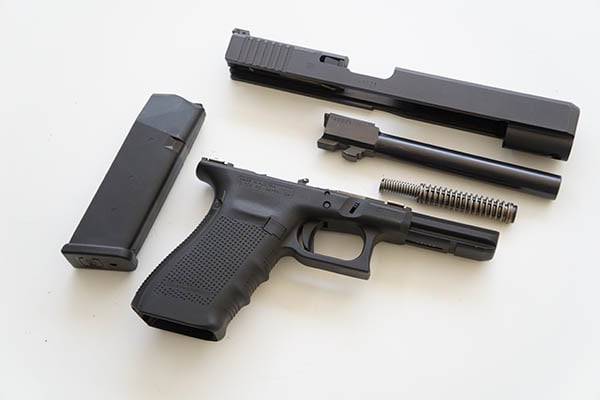
Last Updated on
The time has come to change what you think when you hear the term “Glock 40.” Up until now, when someone heard that terminology, they have only been able to associate it with a ridiculous street slang referring to a Glock pistol chambered in the .40 S&W cartridge. Subsequently, when one mentions a Glock 10mm, they have either the hardly subcompact dimensions of the model 29 or the duty sized frame of the workhorse model 20 to consider. Thanks to Glock, that changes right now!
For the better part of 2015 following the industry SHOT SHOW in Las Vegas back in January, Glock as teased serious shooters such as big game hunters, who implement handguns as their firearm of choice with the concept of a 10mm geared just for them. Up until now, some shooters have managed to use the model 20 with its 4.60 inch barrel, designed more for tactical applications rather than for hunting or have had to modify the G20 by using a second factory available 6 inch barrel to meet minimum hunting length requirements of at least 5.5 inches in restricted states. This has worked fine over the years if you discount the awkward and quite silly appearance of the extra 1.4 inches of barrel protruding from the slide. The only other recourse for these 10mm “die-hards” was to purchase a 6 inch barrel and matching slide from companies like Lone Wolf, while spending just as much for the parts as they did for the original gun. For those people who have waited for a factory answer to their hunting dreams, this article is for you my friends, as I am one of you!
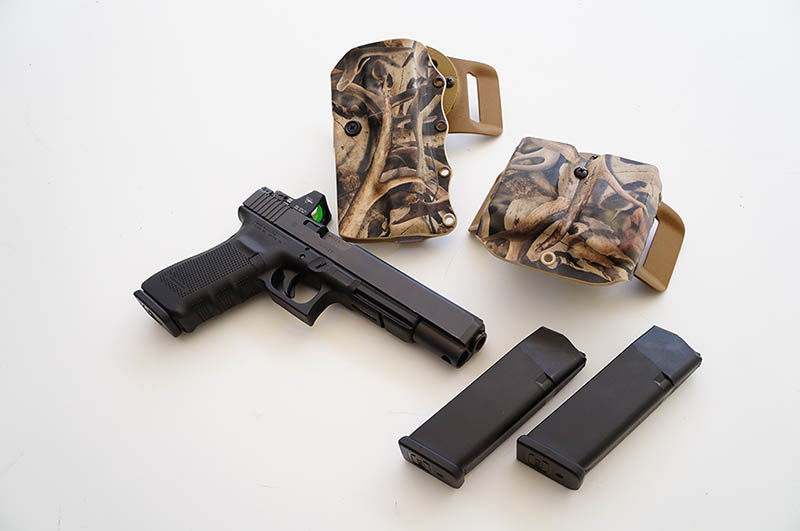
Specs
Meet the NEW definition of the Glock 40, the Glock model 40 MOS that is. On the heels of the new series of Glocks offering a modular optics system allowing for your favorite mini red dot to be directly mounted on the slide, which includes the new G34, G35 and G41, the model new model G40 finally arrived on the market for sale last month. In the interim, plenty of table top reviews have already hit publications throughout the year somehow either by briefly shooting a partial loaded magazine through a demo pistol offered during SHOT SHOW day at the range in the beginning of the year, or by a lot of self-professed Glock experts writing full length articles based purely on what they THINK they know about a pistol they have never even seen other than in the photos they copied in pasted from another site. That is exactly what you will never see here!
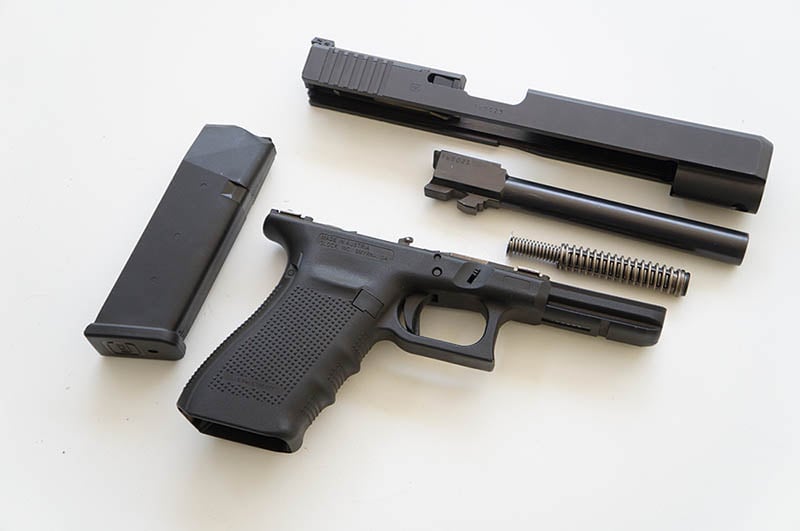
To save you the trouble of having to check the numbers on the manufacturer’s website, let’s look below at how the Glock 40 Gen 4 MOS measures up on paper first.
- Length – 9.49 in.
- Width – 1.28 in.
- Sight Radius – 8.19 in.
- Height – 5.47 in.
- Barrel Length – 6.02 in.
- Weight unloaded – 28.15 oz.
- Trigger pull – 5. 5 lbs. (According to the factory listing)
- Barrel twist – 1 turn in 9.84 in.
- Magazine capacity- 15 rounds (+ 1 in the chamber)
Why 10mm and Why Now?
For those who don’t follow the history of the 10mm, you may wonder why produce another 10mm these days? Isn’t it a pretty much dead cartridge from the 80s? To answer these questions, let’s quickly look at why the market went away from the 10mm in the first place. The round was developed in the early 1980s to give the FBI’s agents a powerful auto loading pistol in the midst of law enforcement leaving the constrictions of the revolver behind. The clear advantage of the semi auto pistol would be the high capacity factor, which ruled out going with the .45 ACP and the tried and true 1911 design. The disadvantage in leaving the revolvers was taking away the power of the standard issue .357 Magnum. In the 1980s, the 9mm round was grossly under powered and did not produce the more impressive ballistics we are finally seeing in today’s loading. The newly developed 10mm was everything the FBI asked for and more. At 1240 fps pushing a 180 grain hollow point projectile, the 10mm clearly out preformed the old .357 revolvers and even firmly pushed the bottom spectrum of the .41 Magnum range. Note, these are two very good hunting rounds in themselves. When handgun hunters saw these ballistic tests published a few years later, it was closely followed by more than just the law enforcement crowd from then on.

The only drawback the 10mm faced was timing. During the development process, a new era in law enforcement occurred by way of not just switching from revolvers to semi autos. Gone were the height / weight restrictions and never admitted gender exclusions. Waves of smaller framed men and now women were joining the FBI’s ranks and would be the first generation to start their careers out equipped with semi auto handguns. Given the all metal construction of the test guns the FBI had chambered in 10mm, the recoil was hard to manage and intimidated agents with very little shooting experience in their backgrounds. This was a clear cut case of a round simply ahead of its time being used in a platform that was an era too late.
Developers looked at all the requirements and eventually decided to cut the casing down and use less powder. This ended up giving birth to the .40 S&W. Over the next 15 to 20 years, this so-called “wonder round” spread like wild fire through the law enforcement community on what has recently been discovered as false marketing. During this time, the 10mm all but faded away from the lime light of the masses. Given a long look at actual in the line of duty shootings involving the .40 S&W round, it has clearly not lived up to the hype.
Luckily, a few firearm manufacturers, such as Colt and Glock, saw the potential of the 10mm and kept working on perfecting the system. With the way the Glock is designed, the polymer frame is built to “flex” slightly during recoil. This “flex” motion acts as a camming action to redirect energy thus reducing the felt recoil of the shot. When firing the same round through an all metal constructed pistol such as a Colt Delta Elite, the shooter feels the energy transferred throughout the unyielding frame and absorbs 100% of the recoil into the hands, wrists and arms. Paired with Glock’s double stack magazines, high capacity and power finally molded themselves into a duty sized pistol by the mid 1990’s. Sadly, it has taken this long for a model to come out with a barrel length long enough to take much more advantage of the 10mm performance. That time is now and the G40 MOS finally offers answers to the questions that have held the 10mm’s success back for years.
Holster Choice
As the holster market is new to the frame size of the G40 which is the same as the earlier released G41 chambered in .45 ACP, a lot of shooters have been carrying this pistol in an open ended G20 / G21 holster with the remaining inch or so protruding from the bottom exposing the all-important front sight to rough and tumble of normal everyday carry abroad. This is not a suitable option for my taste, so I reached out to my close friend, John Phillips at Survivor Creek Tactical to have a custom kydex rig made for my specific needs of carrying both the pistol and a pair of 15 round back up magazines. My choice for carry for a pistol of this size is on the belt due to this firearm may be called on for rapid deployment if running across a bear, gator or wild boar while out deer hunting. Here in Florida where open carry is outlawed, there is a provision for legal open carry if hunting, camping or fishing, which covers me pretty much anytime I’m in the woods.
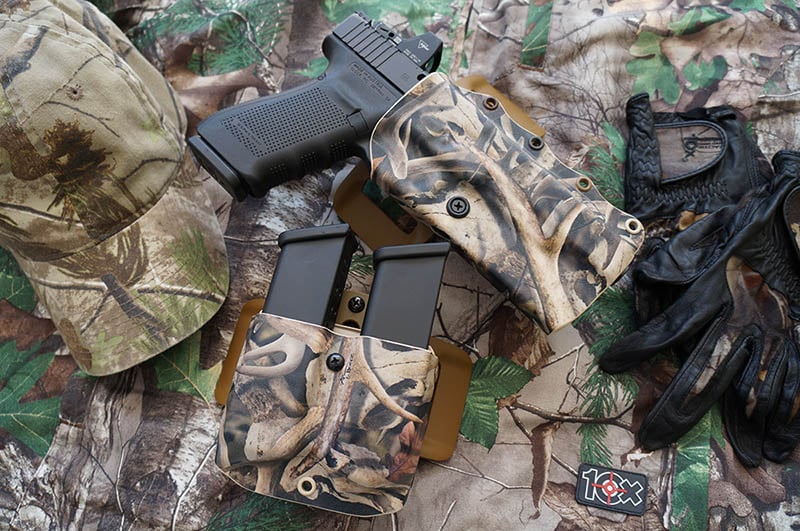
In no time at all, I had a fantastic looking rig cut from a unique pattern kydex simply titled “Bonz.” This new holster and magazine carrier had everything I wanted in a comfortable, secure set up. This rig fit my belt with simple belt loop slide on plates and offered fast on / off attachment via the ingenious RTI mounts connecting the mag carrier and holster to the belt plates with a simple click of a button. As with all of the projects this company has done for me in the past, John’s creations performed excellent during the T&E period.
Field Time
As a long time handgun hunter, certified Glock armorer, former Glock armed SWAT Operator / Deputy Sheriff and overall fan of the 10mm cartridge in general, I can honestly say the Glock 40 Gen 4 MOS isn’t just another slight adjustment by the manufacturer in order to have another model number for fans to collect. With the release of the model 40, it’s a look into several issues the original model 20 managed to fall short on. Unlike most reviews about this particular pistol you will find in magazines and via the internet, I have lived, worked and played with the G40 MOS for almost 3 months now. Both in the field hunting and target shooting as well as using it as a teaching device for my private classes and my volunteer work as an instructor for the non-profit ladies national shooting organization, The Well Armed Woman, the G40 has seen plenty of range time.
One of the added features to the MOS line of pistols is the addition of the adjustable rear sights which helps slightly dial in what is already a very good “out of the box” sight alignment. These are a definite upgrade to the standard fixed offering on most Glocks, but a topic of discussing replacement at a later date. One drawback of the entire MOS line is in the lack of use you will get with the factory sights when using your favorite micro red dot such as the Leupold Delta Point or Trijicon RMR. In order to co-witness the sighs, an investment in suppressor height sights may be in order later.
While the Trijicon RMR was used during the first month of the T&E period with great results, it has never failed me to go hunting on the day my batteries are going to die in any device I carry. For this reason, the remainder of the test period was done solely using the factory iron sights. Using both the red dot and the iron sights, bench rest testing seemed to stay dead on with most industry ballistic charts using several different manufacturers producing 180 grain full power loads. The groupings averaged around 1.70 inches across the board with the tightest being an inch and half with 3 of 5 strings of 5 shot rounds from Hornady and largest being from Remington at just over 2.2 inches in 4 of 5 strings of fire.
Ammo of Choice
After test firing several different loads by top manufacturers, one of my two favorite loads ended up being the last thing you would imagine using in any Glock, lead! That’s right; you read it correctly, a lead projectile. Traditionally, Glock shooters are warned in plain English printed in black and white inside every Glock owner’s manual, DO NOT SHOOT LEAD PROJECTILES. This is due to the polygonal rifling having a tendency to cut deep into the lead, causing serious build up and eventually structural failure by the barrel. This is basically true if you are using swaged lead bullets. Buffalo Bore ammunition has a great reputation for producing top of the line FULL POWER loads for a wide range of calibers. This company uses a TRUE hard cast bullet instead of swaged, which barrel studies have proved does NOT foul the polygonal rifling of a barrel such as a Glock any more than any other type of rifled bullet. Listed below were my top two choices and their average muzzle velocities for what I would carry for hunting white tail deer (180 grain JHP) and what my recommendation for hunting wild boar or using as self-protection while hiking or fishing in big bear country (220 grain FN) based on average expansion, penetration and accuracy both during testing and based off of industry data gathered over the past 8 months.
- Heavy 10mm 180 Jacketed Hollow Point at 1360 FPS
- Heavy 10mm Outdoorsman 220 Hard Cast Lead Flat Nose at 1200 FPS
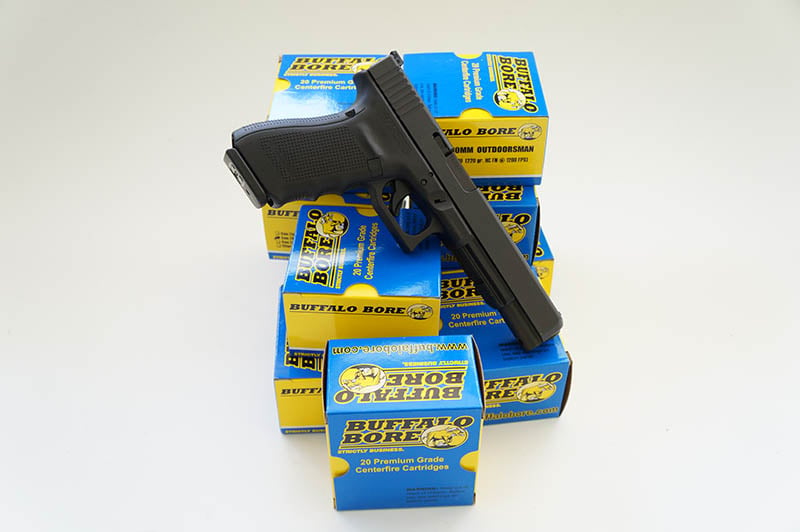
Final Thoughts
With its longer sight radius, the G40 seemed to point more quickly and allow a faster sight acquisition than when I repeated the test with my personal Glock 40 Gen 4 MOS. In a direct comparison, the G40 seemed to have softer, more controllable recoil allowing it to stay on target better after breaking the shot. This was confirmed by several smaller framed female shooters as well as other male shooters much larger than I, both in which I supervised on the range during the testing process. Unloaded, the G40 feels a bit barrel heavy, but once loaded with a full 15 round magazine, the weight shifted to balance the pistol much better in my hand and not forward of my trigger finger. Looking at the end of the slide at the muzzle of the barrel, you can easily see a more rounded, slightly thinner profile which lends itself to easier re-holstering. Imagine the difference in placing a square block versus a rounded block into a hole without looking and that is what is noticed when placing the G20 and the G40 back into a holster.
A few things I would like to note that are standard on not just the G40, but all Generation 4 Glock models that I don’t normally make comment. First, the trigger felt slightly smoother and lighter than any of my other Gen 4 Glocks I own. I quick series of pulls on my Wheeler electronic trigger scale confirmed the pull to be constantly averaging around 5 to 5.1lbs, this is noticeably under the factory specs given on Glock’s website and definitely physically noticeable when concentrating on breaking “THE SHOT” on a prized hog or deer. Secondly, as part of my hunting gear, I often wear thin leather palm gloves to both camouflage my hands during hunting as well as protect them when moving plant life out of the way walking to my favorite hunting spot. Here in the swamps, marsh and woodlands of Florida, everything in nature is either has razor sharp leaf edges, poisonous or produces needle-like protrusions from its foliage. Wearing a good set of gloves often makes manipulation of a firearm difficult as it cuts the dexterity of your fingers greatly. With the Gen 4 oversized magazine release and the more aggressive texture of the Glock polynoid grip, the pistol remains easy to use and control during live fire even in wet conditions. Even the standard Gen 4 interchangeable back straps come into play with getting a better fit of the pistol to your hand to manage recoil, which is not a huge issue with other calibers.
As with all the pistols in the MOS line up, the G40 was provided with a set of 5 plates. Please note, due to the physical size difference of the G40, the plates will not match up to any of the other models in the series. These five plates allow for quick and easy mounting of your favorite red dot and are numbered specifically for different screw patterns.
01 Cover Plate
05 Eotech, Docter, Insight, Meopta
06 Trijicon RMR
07 C-More
08 Leupold Delta Point
As an overall final opinion on the Glock 40 Gen 4 MOS 10mm, the best way to sum it up is by mentioning I did something I rarely do during firearm testing. When my time with the pistol reached the end of Glock’s loan period, I decided to purchase my test sample from them. Even though I already owned a Gen 4 Glock 20, I would perhaps, not have purchased it if I had known the G40 would be released in the near future. Make no mistake, with its relatively large size, this is not a new venture into a daily concealed carry weapon, simply my new hiking / hunting companion whether it’s the Florida swamps or one day Rocky Mountains of Colorado.
It’s been a long road for the 10mm platform waiting on a proper handgun to match its assets, but I firmly believe Glock has finally got it right! With the “out of the box” accuracy, easily manageable recoil, high magazine capacity and comfortable carry, the Glock 40 Gen 4 MOS is now my new favorite firearm terminology.

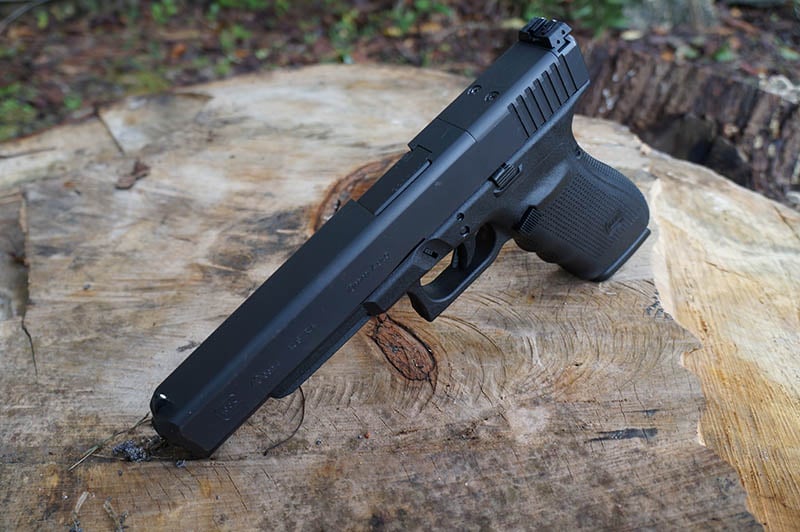



Leave a Reply